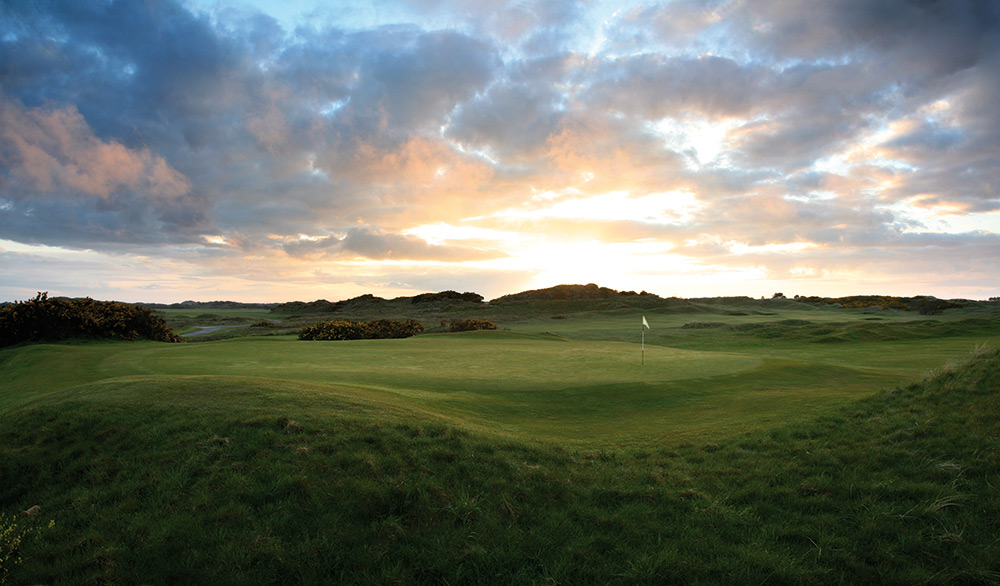
Royal Birkdale became a major championship venue in 1954 and this year it hosted its ninth British Open. Robin Barwick looks back on the Lancashire course’s links with golf’s oldest championship.
Not every club has to receive the Royal Command before they can host the Open, but in Birkdale’s case it did no harm at all.
Birkdale was laid out alongside the coast of northwest England just north of Liverpool by George Lowe in 1889 amid towering dunes and screens of willow scrub, but the challenging Lancashire links only came of age after an update during the 1930s by five times Open champion J.H. Taylor and respected architect Fred Hawtree.
Links courses around the coastline of the British Isles are famed for their sand dunes, which are home to teeming wildlife as well as adding natural beauty and definition to a layout. They can also cause destruction to a scorecard if golfers do not successfully plot a route around or through them, especially when a strong wind is blowing.
Birkdale’s sand hills are part of the largest dune system in the United Kingdom, rising and falling across an area of 5,000 acres along what is known as the Sefton Coast. In Birkdale’s case, the course is almost entirely enveloped by one section of the Sefton Dunes, known locally as the Birkdale Sandhills, and 80 per cent of the land it covers is in fact out of play because it is part of a nature reserve.
Birkdale served its tournament apprenticeship by hosting the British Amateur Championship in 1946, the Curtis Cup in 1948 and the Walker Cup in 1951. Both team trophies were lifted by the United States—an omen, perhaps, as much success would follow here for American visitors over the next half-century.
Birkdale gained its “Royal” status by King George VI in 1951, and three years later the British Open arrived for the first time. In the absence of the previous year’s winner Ben Hogan, Australia’s Peter Thomson, the runner-up in 1952 and 1953, won by a single stroke from three players—the great South African Bobby Locke and the British duo Syd Scott and Dai Rees—to become his country’s first winner of the Open. An epic contribution to golfing history had begun, both from Thomson and Royal Birkdale.
The success of Royal Birkdale as a venue was confirmed when the Open returned seven years later, in 1961. Even fierce gales, which resulted in the second day’s play being abandoned so storm damage could be repaired, failed to derail the challenge of Arnold Palmer, the world’s No 1 player at the time. As Welshman Rees agonizingly finished runner-up, for the third and final time, by a single shot, Palmer sealed his victory with a miracle shot on to the 15th (now the 16th) green out of a bush just off the fairway.
This victory, followed as it was in 1962 with another Claret Jug for Palmer at Royal Troon, firmly established one of the most enduring and endearing relationships between a player and a tournament in the history of golf. Furthermore, it proved to be the catalyst that rejuvenated the tournament after it had lost some of its luster during the decades either side of World War II.
Royal Birkdale’s next appearance on the Open roster came a mere four years later. Not only was the weather more clement, but television camera towers had sprung up around the course and the field was one of the strongest ever assembled. The names at the top of the first-round leader-board included defending champion Tony Lema from the United States, Thomson, who by now had won four Opens, Argentina’s Roberto de Vicenzo, who would win at Hoylake in 1967, Palmer, Nagle and Ireland’s Christy O’Connor. The lead swapped around continuously before Thomson emerged for his fifth, finest and final Open triumph.
Royal Birkdale also hosted the Ryder Cup for the first time that same year when Byron Nelson’s Americans dominated the final day’s singles to record a 191/2–121/2 win, with Palmer again demonstrating his liking for the course with a total of four points out of a possible six.
The Transatlantic contest returned to the Lancashire club in 1969 and will forever be remembered for one of golf’s greatest acts of sportsmanship. With the scores level and the final singles match—between Jack Nicklaus and reigning Open champion Tony Jacklin—on the 18th green, the American generously conceded his opponent’s three-foot putt for a half and a 16–16 result. As he picked up the Englishman’s ball marker, Nicklaus famously said: “I don’t think you would have missed that putt Tony, but in the circumstances I would never give you the opportunity.” It was the first tie in Ryder Cup history.
The British Open returned to Royal Birkdale in 1971, and into the nearby seaside town of Southport breezed Lee Trevino. The ebullient Texan was in the form of his life at the time having immediately followed up his US Open triumph at Merion a month earlier with a playoff victory at the Canadian Open in Quebec. Tony Jacklin and the previously unsung Taiwanese player Lu Liang Huan were the crowd’s favorites. But Trevino was irrepressible—even a double-bogey on 17 could not shake his confidence as he birdied the last to see off “Mr Lu” by one stroke and Jacklin by two.

While the Open in 1976 belonged convincingly to Johnny Miller, it was also memorable for heralding the arrival of Spain’s Severiano Ballesteros, a hitherto unknown 19-year-old. In baking heat, Ballesteros and Miller dominated the tournament from start to finish, with the fearless Spaniard holding the outright lead after rounds two and three. When it came to the final nine holes, though, Miller’s experience gave him the edge as he romped to a six-shot win over Ballesteros and Jack Nicklaus, who tied for second.
“I had no fear then,” Ballesteros recalls. “At Birkdale I found out how good I could be.”
In 1983, an unknown golfer called Denis Durnian, a club pro from nearby Manchester, set a new nine-hole record score for a major, carding 28, six under par, over the front nine. However, he came back in 38 and his challenge evaporated in the third round. In difficult, windy conditions on the final day, defending champion Tom Watson emerged with birdies at 11, 13 and 16, and a par save from the dunes on 17.
Needing a par-four over the daunting closing hole to retain the Claret Jug, Watson struck “the best 2-iron of my life” 218 yards to within 20 feet from the pin. Two putts later, Watson had become only the fifth golfer to win five Opens.
Ballesteros and defending champion Nick Faldo started brightly in 1991 before fading in the second round. Instead, Australia’s Ian Baker-Finch came to the fore, shooting 64, six under par, to share the third-round lead with the American Mark O’Meara, who had already won the 1987 Lawrence Batley International at Birkdale. Baker-Finch, who played most of his golf on the PGA TOUR, blew the field away at the start of the final round, posting five birdies in the first seven holes. He shot 29 over the front nine and became the first golfer with a double-barreled surname to win a major.
At Royal Birkdale’s most recent Open in 1998, English pre-qualifier Justin Rose, a 17-year-old amateur at the time, enjoyed a great debut on the world stage, tying for fourth after pitching in for a birdie three from 50 yards on the 72nd hole. Ultimately, the week belonged to O’Meara, who doubled his majors’ tally just three months after breaking his duck at the Masters at the age of 41. O’Meara shot 68, two under par, on the Sunday to take compatriot Brian Watts, the leader from rounds two and three, into a playoff in which a birdie at the first of four extra holes was enough to set up victory.
This year sees the Open’s ninth visit to Royal Birkdale—the only venue not to have produced a British winner. Inevitably, the host nation’s expectations will fall on the shoulders of Rose in the hope that he can now reap what he sowed a decade ago. In the absence of Tiger Woods who, it should be remembered, was third in 1998, one shot shy of the O’Meara-Watts playoff, he may never have a better chance.
But the same could be said of several players and, after all, Birkdale does tend to favor Americans.
Follow Us On


| Cookie | Duration | Description |
|---|---|---|
| cookielawinfo-checkbox-analytics | 11 months | This cookie is set by GDPR Cookie Consent plugin. The cookie is used to store the user consent for the cookies in the category "Analytics". |
| cookielawinfo-checkbox-functional | 11 months | The cookie is set by GDPR cookie consent to record the user consent for the cookies in the category "Functional". |
| cookielawinfo-checkbox-necessary | 11 months | This cookie is set by GDPR Cookie Consent plugin. The cookies is used to store the user consent for the cookies in the category "Necessary". |
| cookielawinfo-checkbox-others | 11 months | This cookie is set by GDPR Cookie Consent plugin. The cookie is used to store the user consent for the cookies in the category "Other. |
| cookielawinfo-checkbox-performance | 11 months | This cookie is set by GDPR Cookie Consent plugin. The cookie is used to store the user consent for the cookies in the category "Performance". |
| viewed_cookie_policy | 11 months | The cookie is set by the GDPR Cookie Consent plugin and is used to store whether or not user has consented to the use of cookies. It does not store any personal data. |